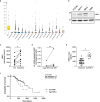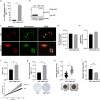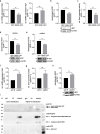NRN1 interacts with Notch to increase oncogenic STAT3 signaling in melanoma
- PMID: 38705997
- PMCID: PMC11071257
- DOI: 10.1186/s12964-024-01632-8
NRN1 interacts with Notch to increase oncogenic STAT3 signaling in melanoma
Abstract
Background: Melanoma is a highly heterogeneous cancer, in which frequent changes in activation of signaling pathways lead to a high adaptability to ever changing tumor microenvironments. The elucidation of cancer specific signaling pathways is of great importance, as demonstrated by the inhibitor of the common BrafV600E mutation PLX4032 in melanoma treatment. We therefore investigated signaling pathways that were influenced by neurotrophin NRN1, which has been shown to be upregulated in melanoma.
Methods: Using a cell culture model system with an NRN1 overexpression, we investigated the influence of NRN1 on melanoma cells' functionality and signaling. We employed real time cell analysis and spheroid formation assays, while for investigation of molecular mechanisms we used a kinase phosphorylation kit as well as promotor activity analysis followed by mRNA and protein analysis.
Results: We revealed that NRN1 interacts directly with the cleaved intracellular domain (NICD) of Notch1 and Notch3, causing a potential retention of NICD in the cytoplasm and thereby reducing the expression of its direct downstream target Hes1. This leads to decreased sequestration of JAK and STAT3 in a Hes1-driven phosphorylation complex. Consequently, our data shows less phosphorylation of STAT3 while presenting an accumulation of total protein levels of STAT3 in association with NRN1 overexpression. The potential of the STAT3 signaling pathway to act in both a tumor suppressive and oncogenic manner led us to investigate specific downstream targets - namely Vegf A, Mdr1, cMet - which were found to be upregulated under oncogenic levels of NRN1.
Conclusions: In summary, we were able to show that NRN1 links oncogenic signaling events between Notch and STAT3 in melanoma. We also suggest that in future research more attention should be payed to cellular regulation of signaling molecules outside of the classically known phosphorylation events.
Keywords: Melanoma; NRN1; Notch; STAT3.
© 2024. The Author(s).
Conflict of interest statement
The authors declare no competing interests.
Figures





Similar articles
-
Signs and symptoms to determine if a patient presenting in primary care or hospital outpatient settings has COVID-19.Cochrane Database Syst Rev. 2022 May 20;5(5):CD013665. doi: 10.1002/14651858.CD013665.pub3. Cochrane Database Syst Rev. 2022. PMID: 35593186 Free PMC article.
-
Integrin αVβ1-activated PYK2 promotes the progression of non-small-cell lung cancer via the STAT3-VGF axis.Cell Commun Signal. 2024 Jun 6;22(1):313. doi: 10.1186/s12964-024-01639-1. Cell Commun Signal. 2024. PMID: 38844957 Free PMC article.
-
Systemic pharmacological treatments for chronic plaque psoriasis: a network meta-analysis.Cochrane Database Syst Rev. 2017 Dec 22;12(12):CD011535. doi: 10.1002/14651858.CD011535.pub2. Cochrane Database Syst Rev. 2017. Update in: Cochrane Database Syst Rev. 2020 Jan 9;1:CD011535. doi: 10.1002/14651858.CD011535.pub3. PMID: 29271481 Free PMC article. Updated.
-
Systemic pharmacological treatments for chronic plaque psoriasis: a network meta-analysis.Cochrane Database Syst Rev. 2021 Apr 19;4(4):CD011535. doi: 10.1002/14651858.CD011535.pub4. Cochrane Database Syst Rev. 2021. Update in: Cochrane Database Syst Rev. 2022 May 23;5:CD011535. doi: 10.1002/14651858.CD011535.pub5. PMID: 33871055 Free PMC article. Updated.
-
[Volume and health outcomes: evidence from systematic reviews and from evaluation of Italian hospital data].Epidemiol Prev. 2013 Mar-Jun;37(2-3 Suppl 2):1-100. Epidemiol Prev. 2013. PMID: 23851286 Italian.
Cited by
-
Performance of urine DNA Neuritin 1 methylation test for urothelial carcinoma detection.Mol Biomed. 2025 Feb 8;6(1):8. doi: 10.1186/s43556-025-00245-y. Mol Biomed. 2025. PMID: 39920484 Free PMC article. No abstract available.
References
Publication types
MeSH terms
Substances
Grants and funding
LinkOut - more resources
Full Text Sources
Medical
Molecular Biology Databases
Research Materials
Miscellaneous

